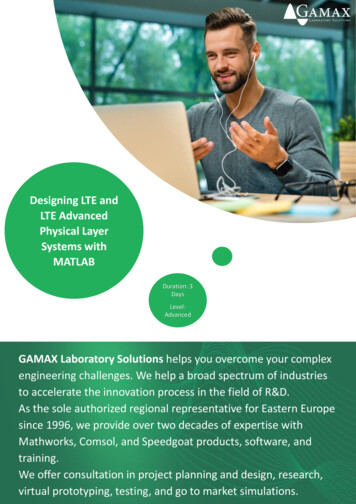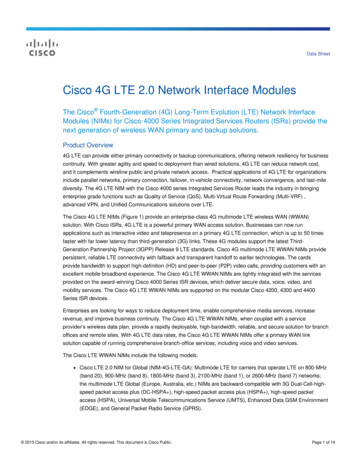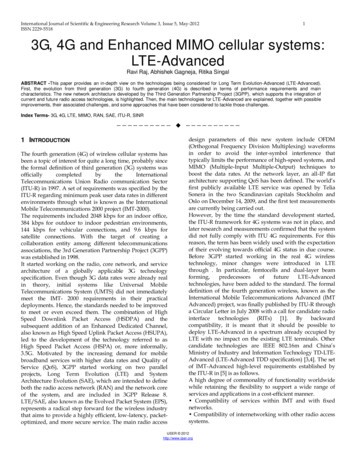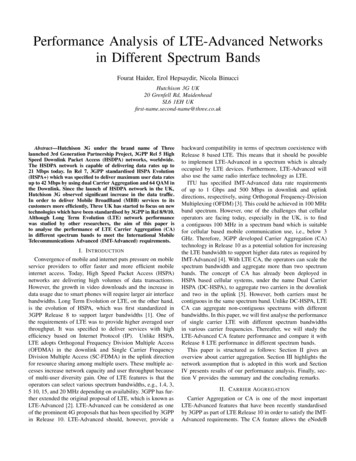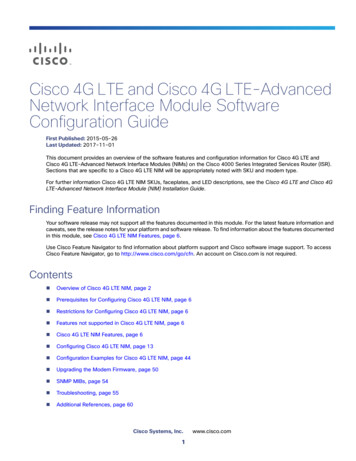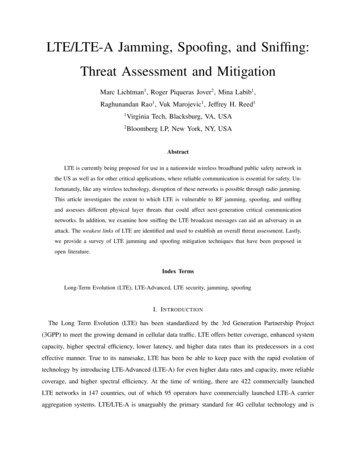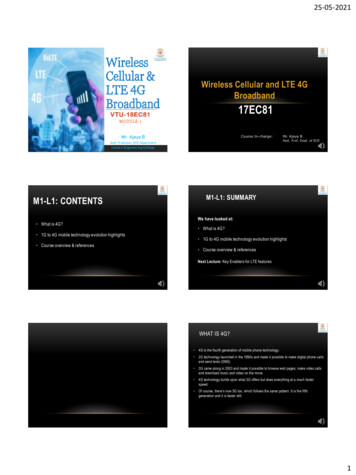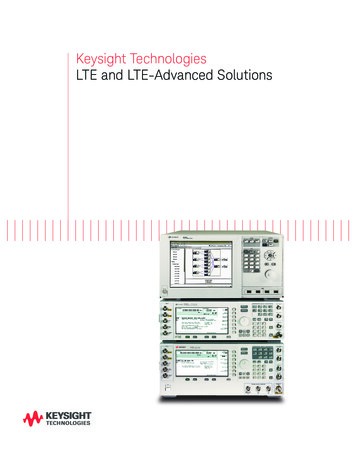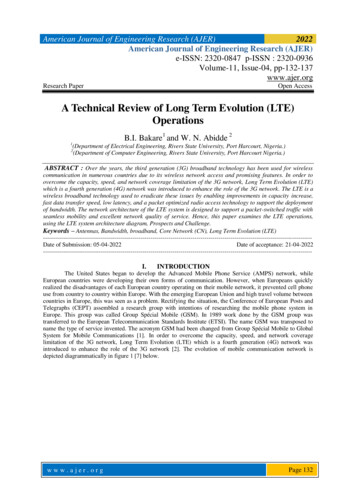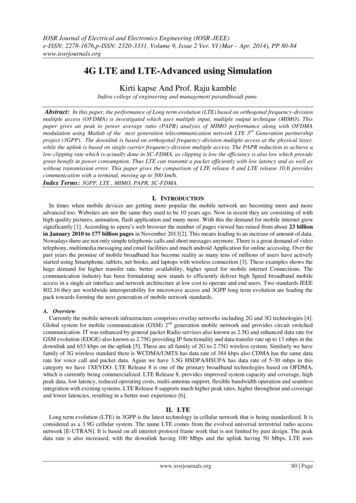
Transcription
IOSR Journal of Electrical and Electronics Engineering (IOSR-JEEE)e-ISSN: 2278-1676,p-ISSN: 2320-3331, Volume 9, Issue 2 Ver. VI (Mar – Apr. 2014), PP 80-84www.iosrjournals.org 4G LTE and LTE-Advanced using SimulationKirti kapse And Prof. Raju kambleIndira college of engineering and management parandhwadi pune.Abstract: In this paper, the performance of Long term evolution (LTE) based on orthogonal frequency-divisionmultiple access (OFDMA) is investigated which uses multiple input, multiple output technique (MIMO). Thispaper gives an peak to power average ratio (PAPR) analysis of MIMO performance along with OFDMAmodulation using Matlab of the next generation telecommunication network LTE 3rd Generation partnershipproject (3GPP). The downlink is based on orthogonal frequency-division multiple access at the physical layer,while the uplink is based on single carrier frequency-division multiple access. The PAPR reduction to achieve alow clipping rate which is actually done in SC-FDMA, as clipping is low the efficiency is also low which providegreat benefit in power consumption. Thus LTE can transmit a packet efficiently with low latency and as well aswithout transmission error. This paper gives the comparison of LTE release 8 and LTE release 10.It providescommunication with a terminal, moving up to 500 km/h.Index Terms: 3GPP, LTE , MIMO, PAPR, SC-FDMA.I. INTRODUCTIONIn times when mobile devices are getting more popular the mobile network are becoming more and moreadvanced too. Websites are not the same they used to be 10 years ago. Now in recent they are consisting of withhigh quality pictures, animation, flash application and many more. With this the demand for mobile internet grewsignificantly [1]. According to opera’s web browser the number of pages viewed has raised from about 23 billionin January 2010 to 177 billion pages in November 2013[2]. This means leading to an increase of amount of data.Nowadays there are not only simple telephonic calls and short messages anymore. There is a great demand of videotelephony, multimedia messaging and email facilities and much android Application for online accessing. Over thepast years the promise of mobile broadband has become reality as many tens of millions of users have activelystarted using Smartphone, tablets, net books, and laptops with wireless connection [3]. These examples shows thehuge demand for higher transfer rate, better availability, higher speed for mobile internet Connections. Thecommunication industry has been formulating new stands to efficiently deliver high Speed broadband mobileaccess in a single air interface and network architecture at low cost to operate and end users. Two standards IEEE802.16 they are worldwide interoperability for microwave access and 3GPP long term evolution are leading thepack towards forming the next generation of mobile network standards.A. OverviewCurrently the mobile network infrastructure comprises overlay networks including 2G and 3G technologies [4].Global system for mobile communication (GSM) 2nd generation mobile network and provides circuit switchedcommunication. IT was enhanced by general packet Radio services also known as 2.5G and enhanced data rate forGSM evolution (EDGE) also known as 2.75G providing IP functionality and data transfer rate up to 13 mbps in thedownlink and 653 kbps on the uplink [5]. These are all family of 2G to 2.75G wireless system. Similarly we havefamily of 3G wireless standard there is WCDMA/UMTS has data rate of 384 kbps also CDMA has the same datarate for voice call and packet data. Again we have 3.5G HSDPA/HSUPA has data rate of 5-30 mbps in thiscategory we have 1XEVDO. LTE Release 8 is one of the primary broadband technologies based on OFDMA,which is currently being commercialized. LTE Release 8, provides improved system capacity and coverage, highpeak data, low latency, reduced operating costs, multi-antenna support, flexible bandwidth operation and seamlessintegration with existing systems. LTE Release 8 supports much higher peak rates, higher throughout and coverageand lower latencies, resulting in a better user experience [6].II. LTELong term evolution (LTE) in 3GPP is the latest technology in cellular network that is being standardized. It isconsidered as a 3.9G cellular system. The name LTE comes from the evolved universal terrestrial radio accessnetwork [E-UTRAN]. It is based on all internet protocol frame work that is not limited by past design. The peakdata rate is also increased, with the downlink having 100 Mbps and the uplink having 50 Mbps. LTE useswww.iosrjournals.org80 Page
4G LTE and LTE-Advanced using SimulationMultiple-input, Multiple-output (MIMO) technique. The downlink is based on orthogonal frequency divisionmultiple access (OFDMA) at the physical layer, while the uplink is based on single carrier frequency divisionmultiple access (SC-FDMA). Each radio frame is 10 ms long and can be divided into sub frame each of 1 msduration. Each sub frame can be further divided into two slots, each of 0.5 ms duration. LTE also uses transmissionpower control (TPC) and Adaptive modulation and coding (AMC). Access to the network is dependent on thephysical layer, medium access control, radio link control, packet data convergence protocol, and radio resourcecontrol. Tight interaction among these building blocks is necessary to transmit a packet efficiently with low latencyand as well as without transmissions error [7].A. OverviewLTE is a long term evolution support data rate of 100 mbps in downlink and 50 mbps in uplink both reachedwith20 MHz spectrum. LTE is available for both FDD and TDD modes. LTE is 3 faster than HSPA , even thoughboth are often branded 4G with faster pings. LTE offers vastly improved performance for VOIP services likeSkype. Ping is significant because a high ping reduces the impact of fast download speeds, as every packet ofinformation download needs to be acknowledged.B. FeaturesLTE uses orthogonal frequency division multiple access (SCFDMA) in the uplink [8]. It has evolved EDGEcapabilities available to significantly increases EDGE throughput rates and announced deployment. HSPA peakspeeds further increased to peak rates of 42 mbps based on Release 8. LTE introduced for next generationthroughput performance using 2x2 MIMO. Advanced core architecture available through EPC primary for LTE,but also for HSPA , providing benefits such as integration of multiple network types and flatter architecture forbetter latency performance. LTE enhancement such as 4x MIMO and dual carrier available. Now in 2012 laterLTE-Advanced potentially deployed in initial stages and HSPA with MIMO and quad carrier available, newservices implemented in the packet domain.Figure shows the LTE frame structureFig 1. Shows LTE frame structureFig 1 shows the LTE frame structure. It supports both FDD and TDD also difference between two is the presenceof a sub frame to provide guard time for downlink to uplink switching. Because of using OFDM, LTE can usechannel dependent scheduling in both times as well as in frequency domain. For each 1 ms sub frame in which userare allowed to transmit. In the frequency domain, the scheduler granularity is 180 KHz. Both downlinks and uplinktransmission are controlled by the scheduler located in the base station. The scheduler is the key element anddetermines the overall downlink system performance. The instantaneous channel quality at the terminals is find outand again fed back to the base station as per sub frame. In the uplink the terminal can be configured to transmit asounding reference signal which may be used for uplink channel dependent scheduling.Advanced features of LTE:a) Time-Frequency Domain Scheduling:In LTE, time and frequency domain channel-dependent scheduling is supported for both uplink (PUSCH), anddownlink (PDSCH). This is achived through acquiring the CQIs of the respective channel. By doing so, multiuserdiversity gain is achived.b) Link Adaptation:In LTE, downlink supports QPSK and 16-QAM, and 64-QAM modulation. In uplink, QPSK and 16-QAM aresupported, with 64-QAM being optional. LTE supports various link adaptation including transmission powercontrol, adaptive modulation, and coding as well as adaptive bandwidth allocation.www.iorjournals.org81 Page
4G LTE and LTE-Advanced using Simulationc) MBMS:LTE supports MBMS through single frequency network(SFN). All cell provide the broadcasting using the sameset of resources. The signal coming from the surrounding cells are treated as multipled delayed version using longCP.d) MIMO:To achieve a 100 Mbps peak data rate in downlink transmission over a 20-MHz bandwidth, two independentdata streams are multiplexed through 2 2 MIMO or 4 2 MIMO system.III. LTE –ADVANCEDLTE Release 10, also known as LTE-Advanced includes all the features of Release 8/9 and adds new featureswhich enhanced multi antenna support. In order to achieve 1 Gb/s peak data rate in future IMT-Advanced mobilesystems, carrier aggregation technology is introduced by the 3 GPP to support very high data rate transmission overwide frequency bandwidth in its LTE-Advanced standards [9]. One of the most important LTE-Advance benefits isthe ability to take advantage of advanced topology networks, optimize heterogeneous network with a mix of macrocell with low power nodes such as picocells, femtocells and new relay nodes. The next significant performance leapin wireless network will come from making the most of topology, and brings the networks closer to the user byadding many of this low power nodes-LTE Advance further improves the capacity and coverage, and ensures userfairness. LTE- Advance also introduces multicarrier able to use ultra wide bandwidth, up to 100 MHz of high datarates.A. Overview:LTE officially known as 3GPP Release 10 and beyond Release 12 is still in development by the 3GPPLTE-Advanced, which can be used as a real 4G-telecommunication network. LTE-Advance support highertransfer rates up to 1 gbitps in downlink and 500 mbps for uplink for low mobility.Downlink: Extended SU-MIMO (up to 8 antenna).Support for carrier aggregation with 5carrier component.Release 9 PRS.Release 10 UE specific.Release 10 CSI RSUplink: Uplink SU-MIMO for PUSCH.Uplink spatial diversity.Support for carrier aggregation with 5 carriercomponent.Cluster SC-FDMA.Possibility simultaneous transmission forPUCCH and PUSCH.IV. COMPARISON OF LTE AND LTE-ADVANCEDFeaturesGenerationFirst releasePhysical layerDuplex modeUser mobilityCoverageTransmission bandwidthPeak data rateVoIP capacity other qualitiesLTE3.9 G2009DL OFDMAUL SCFDMATime and Frequency divisionduplexUp to 350 kmphUp to 100 kmDL 20 MHzUL 20 MHzDL 300 MbpsUL 75 Mbps200 active user percell in 5MHzLTE-Advanced4G2011DL OFDMAUL SCFDMASame as LTESame as LTESame as LTEDL 100 MHzUL 40 MHzDL 1 GbpsUL 500 Mbps3 times higher as compared toLTETable 1: Comparison of LTE and LTE-Advanced.www.iorjournals.org82 Page
4G LTE and LTE-Advanced using SimulationV. BLOCK DIAGRAM OF SC-FDMA AND OFDMA WITH RECEIVER AND TRANSMITTER:Figure 3: Block diagram of SC-FDMA with transmitter and receiver.Figure 3: Block diagram of OFDMA with transmitter and receiverVI. MATLAB RESULTS:www.iosrjournals.org83 Page
4G LTE and LTE-Advanced using SimulationVII. CONCLUSION OF THE PAPER:LTE successfully run all over the world wide and its growth continue unabated. With this LTE is expected tosupport different types of application such as: Web browsing, File transfer protocol (FTP), Video streaming, Musicstreaming, Voice over IP, network gaming, Real time video, Push to talk (PTT) and Push to view (PTV). Alsowith this SC-FDMA is the better option for cellular uplink in LTE, because of its higher efficiency due to lowPAPR, its lower sensitive to frequency offset consumption in the uplink, and OFDMA in the downlink which havebeen shown in matlab figure. We can minimize the PAPR ratio with respect to SC-FDMA and OFDMA. In thispaper we have plotted the CCDF that is known as Complementary cumulative distribution function of theamplitude of a signal sample is given by,F(Z) 1-eZThe CCDF of the PAPR of a data block with Nyquist rate sampling is,P(PAPR Z) 1-P(PAPR Z) 1-F(Z)Z 1-(1-F(Z)N)Assuming that N times domain signal samples which are mutually independent and ].[9].Emad kazi, Rajan pillai, uzair Qureshi, Awab faikh, Long term evolution. IOSR journal of Electronics and communicationengineering sept- Oct 2013.State of the mobile web, October 2013, “Opera tech report, oct-2013.Rysavy research, Transition to 4G, 3GPP broadband evolution to IMT-Advance sept-2010.Dieter eberle, LTE Vs WIMAX, 4G telecommunication network Berlin institute of technology Germany sept-2010.MOHD Azharuddin, Comparison between LTE Advance Vs WImax release 2.0 for communication network .G Yuan, X Zhang, W Wang, Y Yang, Carrier Aggregation-LTE Advanced Mobile communication system, IEEE communicationMagazine 2010.Wireless Broadband network, D. Chong Wong, p yong Kong, Y chang Liang, K chaing chua, and J w mark 2009.MOHD Azharuddin, Comparison between LTE Advance Vs WImax release 2.0 for communication network.R. Nossenson, “Long term evolution network architecture in microwave communication engineering magazine, IEEE internationalconference in 2009.www.iosrjournals.org84 Page
LTE- Advance also introduces multicarrier able to use ultra wide bandwidth, up to 100 MHz of high data rates. A.Overview: LTE officially known as 3GPP Release 10 and beyond Release 12 is still in development by the 3GPP LTE-Advanced, which can be used as a real 4G-telecommunication network. LTE-Advance support higher

